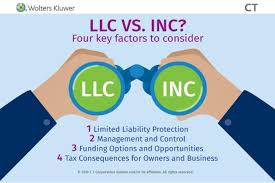LLC Big Tax Consequences Many Unaware Of
How Partnership Income Is Taxed
Generally, the IRS does not consider partnerships to be separate from their owners for tax purposes; instead, they are considered pass-through tax entities. This means that all of the profits and losses of the partnership pass through the business to the partners, who pay taxes on their share of the profits (or deduct their share of the losses) on their individual income tax returns. Each partner’s share of profits and losses is usually set out in a written partnership agreement.Filing Tax Returns
Even though the partnership itself does not pay income taxes, it must file Form 1065 with the IRS. This form is an informational return the IRS reviews to determine whether the partners are reporting their income correctly. The partnership must also provide a Schedule K-1 to the IRS and to each partner, which breaks down each partner’s share of the business’s profits and losses. In turn, each partner reports this profit and loss information on his or her individual tax return (Form 1040), with Schedule E attached.Estimating and Paying Taxes
Because there is no employer to compute and withhold income taxes, each partner must set aside enough money to pay taxes on his share of annual profits. Partners must estimate the amount of tax they will owe for the year and make payments to the IRS (and usually to the appropriate state tax agency) each quarter in April, July, October, and January. Profits Are Taxed Whether Partners Receive Them or Not The IRS requires each partner to pay income taxes on his distributive share. This is the portion of profits to which the partner is entitled under a partnership agreement or under state law if the partners didn’t make an agreement. The IRS treats each partner as though he or she received his distributive share each year. This means that you must pay taxes on your share of the partnership’s profits total sales minus expenses regardless of how much money you actually withdraw from the business. The practical significance of the IRS rule about distributive shares is that even if partners need to leave profits in the partnership, for instance, to cover future expenses or expand the business each partner will owe income tax on his or her rightful share of that money. (If your business will regularly need to retain profits, you should consider incorporating, corporations offer some relief from this particular tax bite. To learn more, see Incorporating Your Business May Cut Your Tax Bill, below.) Establishing the Partners’ Distributive Shares Unless business partners make a written partnership agreement that says otherwise, state law usually allocates profits and losses to the partners according to their ownership interests in the business. This allocation determines each partner’s distributive share. For instance, if Andre owns 60% of a partnership and Jenya owns the other 40%, Andre will be entitled to 60% of the partnership’s profits and losses and Jenya will be entitled to 40%. (In addition, state law assumes that each partner’s interest in the business is in proportion to the value of his or her initial contribution to the partnership.) If you’d like to split up profits and losses in a way that is not proportionate to the partners’ percentage interests in the business, it’s called a special allocation, and you must carefully follow IRS rules.Self-Employment Taxes
If you are actively involved in running a partnership, in addition to income taxes, the IRS requires you to pay self-employment taxes on all partnership profits allocated to you. Self-employment taxes consist of contributions to the Social Security and Medicare programs, similar to the payroll taxes employees must pay. There are some differences between the contributions regular employees make and the contributions partners must make. First, because no employer withholds these taxes from partners’ paychecks, partners must pay them with their regular income taxes. Also, partners must pay twice as much as regular employees, because employees’ contributions are matched by their employers. However, partners can deduct half of their self-employment tax contributions from their taxable income, which lowers their tax bill a bit. The self-employment tax rate for 2009 is 15.3% of the first $106,800 of income and 2.9% of everything over that amount. Partners report their self-employment taxes on Schedule SE, which they submit annually with their personal income tax returns. Expenses and Deductions You may be wondering how you will survive financially, after paying income taxes, Social Security taxes, and Medicare taxes on your share of business income, even if you don’t withdraw it from your business. Luckily, you don’t have to pay taxes on most of the money your business spends to make a buck. You and your partners can deduct your legitimate business expenses from your business income, which will greatly lower the profits you have to report to the IRS. Deductible expenses include start-up costs, operating expenses, travel costs, and product and advertising outlay, as well as a portion of the money you spend on business-related meals and entertainment. Incorporating Your Business May Cut Your Tax Bill Unlike a partnership, a corporation pays its own taxes on all corporate profits left in the business. Owners of corporations pay income taxes only on money they receive as compensation for services (salaries and bonuses) or as dividends. While many small businesses would rather not file a corporate tax return, incorporating can offer business owners a tax advantage over a partnership’s pass-through taxation. This is especially true for businesses that expect to retain profits in the business from year to year. If you need to keep profits (called retained earnings) in your business, you may benefit from lower corporate tax rates, at least for the first $50,000 – $75,000 of profits per year. For example, if your retail outfit needs to stock up on expensive inventory, you might decide to leave $30,000 in your business at the end of a year. If you operate as a partnership, these retained profits will likely be taxed at your marginal individual tax rate, which is probably more than 25%. But if you incorporate, that $30,000 will be taxed at a lower 15% corporate rate.LLC Big Tax Consequences Many Unaware Of
Welcome to the Gutenberg Editor
The goal of this new editor is to make adding rich content to WordPress simple and enjoyable. This whole post is composed of pieces of content—somewhat similar to LEGO bricks—that you can move around and interact with. Move your cursor around and you’ll notice the different blocks light up with outlines and arrows. Press the
How to Increase Profit Margins Through Virtual CFO Services
How to Increase Profit Margins Through Virtual CFO Services

Great Accounting Firms Share These 10 Traits
Great Accounting Firms Share These 10 Traits which has gone far beyond the paper-pushing days and now involves acting as a virtual CFO

Tax Accountant in Miami Cope with IRS Tax Season Delay
Tax Accountant said IRS delays start of tax season for individual returns would be postponed until February 17 with some as late as March

Miami Accountants Philosophy of Up or Out
Its up or out for Miami Accountants firms are faced with the dilemma of keeping long-term managers that are not ready to be equity partners or let them go.

Contadores en Miami Explican Auditorías del IRS
Contadores en Miami, Gustavo A Viera CPA, explica los pasos de una auditoría, desde la notificación de la auditoría hasta el cierre de la misma
Home » Tax Services » LLC Big Tax Consequences Many Unaware Of

